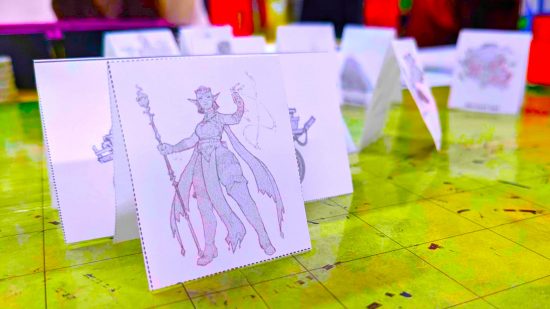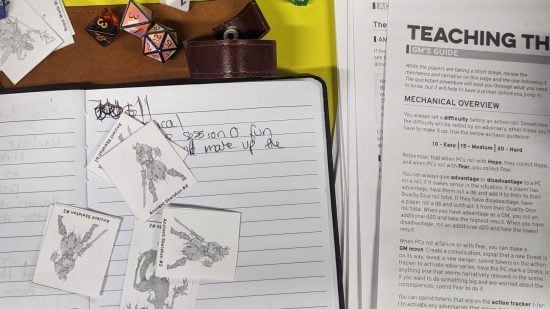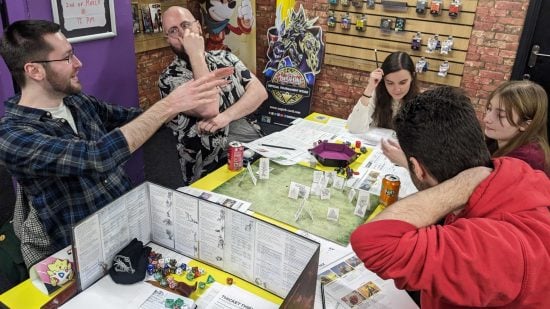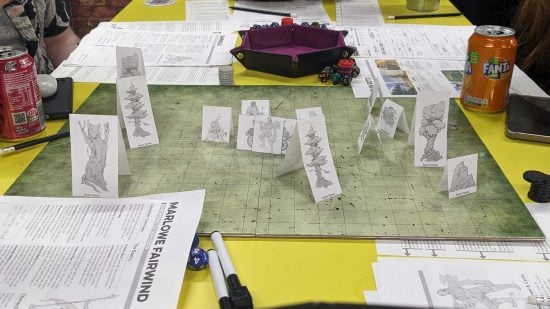Daggerheart is exactly what you’d expect an actual-play-adjacent tabletop RPG to be. The new, currently-in-beta title from Darrington Press takes much of its structure and aesthetic from the game that made Critical Role famous – Dungeons and Dragons. But this version of the classic hero fantasy puts storytelling above all, and it cuts the crunch that might bog down a snappy, stream-friendly improv session.
Basically, this is D&D for players who give zero damns about combat.

While I may sound overly skeptical, this approach does have its strengths. First is familiarity. When my table sat down to playtest Daggerheart’s quickstart adventure, the uphill battle of learning the rules was more of a gentle incline.
The tale is still told in a fantasy realm that vaguely imitates Medieval Europe and Tolkien-esque tropes. Everyone still plays a humanoid of whimsical origin, whose unusual skills and powers can be summarized by six core stats.
The character sheet, though slimmer than D&D’s, still lists your class and subclass, your armor, weapons, and spells. Rogues still sneak attack, and Sorcerers can still modify their innate brand of magic.
Even Daggerheart’s differences feel familiar. Its core dice – two d12s that you roll whenever you take an action or make an attack – are labelled ‘Hope’ and ‘Fear’, and they offer boons to the players or the GM depending on which die rolls higher. ‘Hope’ rolls give the player bonuses, and ‘Fear’ rolls let the GM introduce a negative consequence. This highly thematic approach echoes games like Warhammer’s Wrath and Glory.
The stress point system, which tracks the emotional toll of your adventures alongside the physical, seems heavily inspired by the Forged in the Dark system. Plus, Spenser Starke’s work on Alice is Missing might explain why each class has their own deck of cards to play with.
Each mechanic has a narrative edge, encouraging players to consider the story implications of their moves. Similarly, the quickstart adventure includes an in-depth session zero where your party establishes their relationships before setting off. Players are regularly prompted to describe parts of the world they’re exploring, giving them some agency over the game’s lore and direction.
So far, so rules-light-RPG-system. But it’s Daggerheart’s combat that takes this story-first approach to its extreme conclusion.
Most shockingly, Daggerheart dumps the idea of Initiative. There are no rounds, and there is no turn order. Players who wish to move and act instead place a token on an action tracker. They can do this as many times as they want, at any time they like. The GM only gets to activate the enemy NPCs if someone rolls ‘with Fear’, netting a higher result on their Damocles-themed d12.
I was initially horrified by this Wild West proposal, but the play experience was a pleasant surprise. The free-form approach to battle is punchy and fast-paced, with eager players throwing down their tokens while more careful ones take time to consider their approach.
One player admitted that D&D’s combat often bores them, and they were grateful that Daggerheart gave them the opportunity to take a back seat. This even became a core part of their character arc. Their haughty Nobleborn was reluctant to dirty their hands fighting with the peasantry when the game began, but several battles and bonding sessions later, they were ready to give their all in the final fight.
This represents the best-case scenario for a game of Daggerheart. When combined with a table of motivated players who prefer roleplay to wargames, you’ve got a safe recipe for success. The game is dynamic and collaborative, and creative gamers can easily add flavor.
But what about tables who are gluttons for strategy? They may be irked by Daggerheart’s attention to detail – or lack thereof. The game’s approach to range, terrain, and damage types can only be described as ‘don’t think too hard about it’.
The quickstart adventure is played at level one, so there isn’t much opportunity to explore each class option. This, combined with the streamlined combat rules, meant no one’s character had a distinct mechanical identity. However you hit those skeletons shambling towards you, and wherever you hit them from, it had much the same results.
Strategy aside, Daggerheart also has one major foil – shyness. A group of professional streamers may never hesitate to pipe up, but tabletop RPG groups across the globe are filled with less confident gamers. A GM must watch for any signs of reluctance or risk leaving a player behind, their mouths closed and their thumbs twiddling.
Daggerheart’s break-neck pace makes it difficult to stay vigilant. When players are free to take action at any time, turns become rapid-fire, and the GM must be ready to respond. A Fear roll could also come at any point, pivoting the spotlight to the GM themselves. All the while, they must play the eye of Sauron, observing the action from the outside while also facilitating it from within.
Such plate spinning might not phase Matt Mercer, but I’m just plain old Mollie Russell. And while I enjoyed running Daggerheart, I can’t help feeling that its tweaks to D&D’s combat will create as many problems as they solve.
For lovers of dungeon-crawlers, here’s how the new Gloomhaven game plays on a moving train. And for those still playing fifth edition, here’s all you need to choose your next DnD classes and DnD races.



